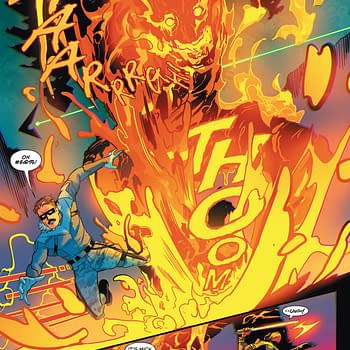Posted in: Comics | Tagged: Comics, dynamite, entertainment, green hornet, lone ranger, michael uslan
Michael Uslan On Finally Making The Lone Ranger / Green Hornet Connection
Film producer and writer Michael Uslan talks with Byron Brewer about Lone Ranger/Green Hornet #3, on sale now from Dynamite. Cover by Jan Duursema and interior art by Giovanni Timpano.

MICHAEL USLAN: I have known for many decades about the relationship between The Lone Ranger and The Green Hornet, as created primarily by writer Fran Striker. I have also been aware for a long time of the legal difficulty in finally being able to tie these two members of the Reid family together in one family saga. So for quite a while, I had been nudging Nick Barrucci to be a magician and legally make this happen after 80 years. When he did, I plunged into my research then my writing with massive adrenalin. As far as my comfort zone with the characters goes, I grew up an awestruck fan of Clayton Moore and Jay Silverheels on The Lone Ranger TV series. When I write these two characters, I write with them in mind. As a young teenager, I discovered the old Lone Ranger dramatic radio series and became familiar with the work of Brace Beamer and others. With respect to The Green Hornet, my initial exposure was actually seeing the golden age comic books, then seeing a few chapters from the 1940s movie serial at New York Comic Con in 1964, followed about a year later by being able to access the old radio series on a radio station in Newark, New Jersey. But it really wasn't until the TV series that Britt Reid and Kato really came to life for me. In my head, I hear the voices of Van Williams and Bruce Lee when I write these characters.
BB: One of the big "wows" in this series – and I do not think we are risking any spoilers here, since it has been discussed in other interviews – is that Tonto comes "from out of the past" to train and guide Kato. Was this a way of upping the import of both classic sidekicks in the story?

BB: I think it is wonderful how you have worked real life folks of the "period," such as Olympian Jesse Owens, into the series. Tell us what you can about the decision to include Owens …
MU: When I chose to set this story historically in 1936 and 1938, I carefully researched all the events in U.S. and world history taking place then. In light of our current national situation regarding racism, I felt that if I utilized Jesse Owens in an important role here that it would give the series, thematically, a very contemporary and important feel. There are issues today just as there were 80 years ago about racism in America. And when I learned that in reality, during Jesse Owens' tickertape parade down Broadway in New York after the 1936 Olympics that some unidentified-to-this-day man rushed his car and threw him a paper bag filled with $10,000 as a thank-you to standing up to Hitler and the Nazis, I realized I had my connection between Jesse Owens and the Lone Ranger.
BB: … And Murder Inc.?

BB: There is also apparently another Reid out there. Can you give us any clues at all about this family trifecta?
MU: Fearful of spoilers here, let me only say that they find themselves related to a certain Sergeant from the Yukon, a member of the Royal Canadian Mounted Police, as well as learning that they are all descendants of Revolutionary War hero "Mad" Anthony Wayne, this tying the Reid family with the Wayne family. Hmmm… I wonder where that could lead!
BB: These first three issues, including #3 now on sale, of Lone Ranger/Green Hornet have had neither the atmospheres (re: mood) of the western LR or the urban GH. Instead, there almost feels a gathering storm coming. If you will not be revealing spoilers, can you hint at what is to come in the series' second half?
MU: If our upcoming issues #4 and 5 of The Lone Ranger/ Green Hornet do not stun you into silence, then I will have failed in my efforts to make this historical story as impactful as it deserves to be. I do ask fans not to reveal the last three pages of either #4 or #5 because the spoiler effect will be too great.
For more on Lone Ranger / Green Hornet #3, click here.














